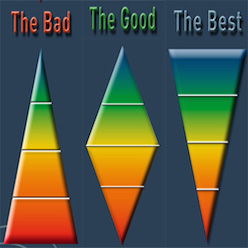Do you want only the best when it comes to housing? Of course you do! Therefore you are critical of the influence your environment has on your health and wellbeing. Therefore, you pay attention to the (re)use of raw materials and energy consumption. That’s why you want a home that is adaptable to your changing needs.
Frontrunners or left behind?
Welcome to the front-runners that go for sustainability and refuse to settle for standard solutions. Because standard solutions never are the best! You arrange the way you live to your own discretion and are willing to invest in that. That makes you an interesting prospect for housing providers, you would think. The average housing association is missing out on opportunities here, because they offer standard solutions with some variations for the masses, for the peloton. BRIQS thinks it is high time for an analysis and a wake-up call, so that in the future you as a front runner can also turn to a housing association for a house to your liking. For this to happen, a lot has to change.
To achieve the best for you, housing associations and other housing providers need to realize that the development from Bad to Good is completely different from the development from Good to the Best. To illustrate that, I want to tell you a little about an Amsterdam renovation project, later on.
From Bad to Good to the Best
From Bad to Good calls for a joint, supply-driven approach where industrial customization is an excellent solution. The peloton will be very pleased with it. From Good to the Best requires something quite different, namely, an individual demand-driven approach so you can say what you want and then also get that. The beauty is that these two ways to come to a solution certainly are not opposites. They complement each other, it’s not IF but AND. A housing association just needs to understand when to opt for one or the other. And another thing! Without clear objectives, a housing association can never make this choice. That is exactly what went wrong in Amsterdam recently.
Double reward
The standards a well-insulated house must meet are described clearly. Nowadays every home has an energy label (A +++ is the best, G is far below par). With an energy label purchasers and tenants can see at a glance whether a home is economical or not. That’s handy, because opting for an economical home means lower energy bills, lower CO2 emissions which is better for the environment and more comfort! In a recent home insulation project in Amsterdam housing associations were doubly rewarded. The houses moved at least two labels ahead, such as from label E to C, and for every house the associations received over € 4,000.00 in subsidy for the promised reduction of CO2. When the Amsterdam audit office looked at the results afterwards they were quite different than expected.
Scoring by moving the target
A striking feature of this project was that the municipality afterwards said that the CO2 reduction target should not be considered to be so definite. Surely the home comforts of the residents had become so much better. That’s a rather odd response for two reasons:
- In all climate reports the subsidy project was announced as CO2 reduction.
- Housing associations have been established to provide comfort, for which they have special fiscal means available (unlike companies).
Finding target on the basis of the result is the world upside down. That’s like shooting the ball and then positioning the goal in line with where the ball is going. That is an easy way to score for all of us!
From Bad to Good
If we want to turn the huge, poorly insulated housing stock into Good homes, this calls for a joint approach of the whole. Energy bills drop and home comforts improves. Point of interest is earning back the investment. Doing that from energy savings or an increase in rent is usually not feasible. Current and proposed residents can never pay these costs in full. So how can we get this job done cheaply, with a good result and practical approach? That result is possible with industrial customization. You create a solution by type of home or block of homes that is suitable for multiple locations on a fairly large scale. The large numbers make it cheaper per home and suitable and accessible for many residents.
Indeed, more than 80% of the homes in the Netherlands consist of less than thirty types of housing. To begin with, this of course requires an investment in these industrial customized solutions. The advantage of this investment is that no unreasonable large loans or high-risk premiums are needed. You use repeated, tested and, for example, certified, insured and guaranteed solutions. In this way you create general, supply-driven solutions for the peloton. Solutions that enable housing associations to increase the home comforts of their tenants for sure, with which they save energy and are repeatedly applicable to other projects
From Good to the Best
The adjustments for the members of the front-runners to go from Good to Better to the Best, requires a different approach. For that you need very personal customized solutions, because what is the Best? That’s something very different for me than it is for you, but it very much determines our opinion after these improvements. What solutions on energy saving in your home fit you best? What personal circumstances determine your needs for heat, light and ventilation? There are people who are very consciously energy efficient and put on a pair of thick socks and a sweater on those few very cold days in the year. For them it is less important to have the perfect insulation than to have heating acting on the low-temperature fueled with waste heat or soil. That does not apply to everyone! On the web site of Energie Nul 73 residents share how they got what they wanted. Conclusion: the art of asking the right questions really takes you from Good to the Best.
Personal needs translated
If you hibernate in Spain you have different demands for your home than when you are at home all winter. Were you born and raised in Indonesia or around the Mediterranean your thermostat may default to 25oC for your feeling of having a decent climate. In that case you need something very different from your home than when 18oC is good enough. Are you into full ventilation? Is your bedroom window always wide open at night even though there is ice on your duvet? Very different solutions are needed. Do you regularly entertain guests, or not? Do you have young children doing (top-level) sports who earn a warm shower several times a day, or is the old fashioned once a week routine enough for you? All these different wishes and personal needs make a big difference on the way to get from Good to the Best. In these cases collective solutions are not easily found. Unless you gather many different customers sharing similar needs. Until recently, direct contact with and between those specific customers, was not really achievable. That situation has changed drastically with social media and the internet. You meet and select your supporters and experts who fulfill your wishes independently and online, right?
What are your ideas and experiences?
How do you think a housing association can offer the best to critical front-runners like you. Should they want to do that at all? On top of that, you can immediately ask the question whether the given subsidies for CO2 reduction through home modifications need to go to housing associations or are better spent elsewhere? BRIQS sees this as a great challenge for policy makers: how to translate the needs of different target groups into an approach of energy and climate.
Take the next step and share your experiences
Do you want to take a next step? Come to the FREE* Masterclass. We will work with practical tools to instantly implement the actions of my ebook in your organizational, fiscal or financial projects and organization.
Join the conversation
Do you know how to build that new way and what you need? Do you have what you need to make the right choice? Share it in the comments below.
To your health and wellbeing,
Remko Zuidema



